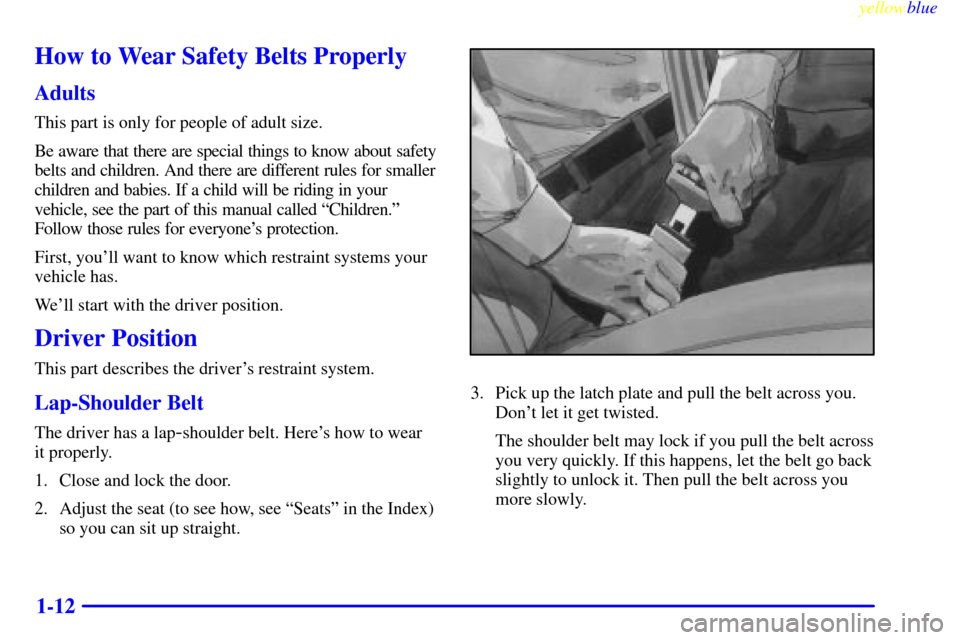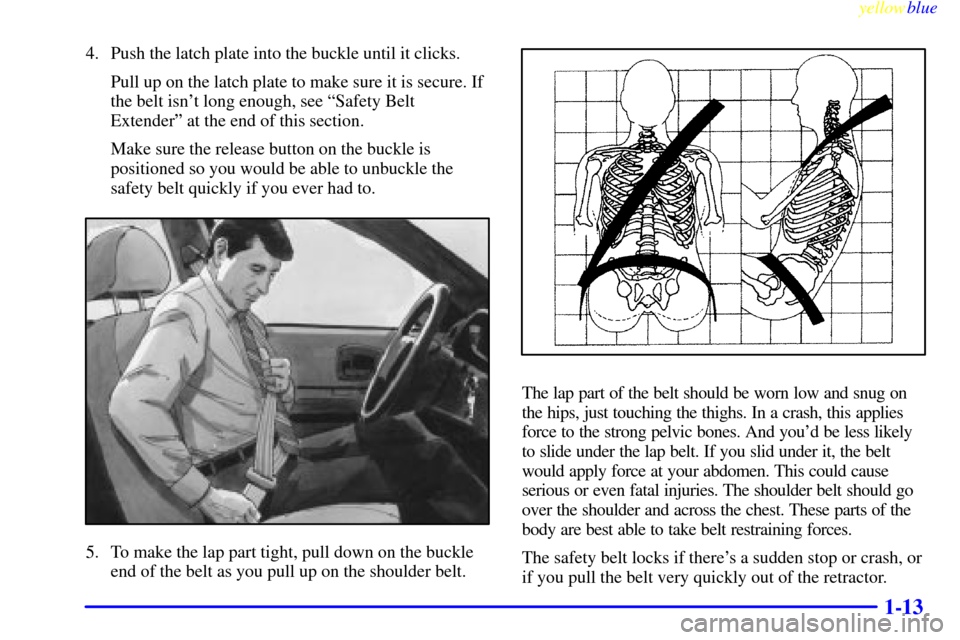Page 4 of 336
yellowblue
iv
In 1932 Chevrolet
introduced the
Synchro
-Mesh
transmission and
offered a host of
accessories -- including
such niceties as a clock!The legacy of America's favorite sportscar
began in 1953, when 319 hand
-assembled
white Corvettes
launched the
first use of a
fiberglass body in
a production car.
The Chevrolet blend of
value and performance has
become an American
tradition -- whether bred for
the racetrack like the legendary
Corvette and Camaro, or created for the pleasure of the
open road.
Every decade, Chevrolet
has reinforced its heritage
of affordable performance
with quality and value crafted into each vehicle. It's not
surprising that for 80 years
ªGenuine Chevroletº has been
America's automobile.
We're proud to continue that
heritage in your Chevrolet,
Page 8 of 336
yellowblue
viii
For example,
these symbols
are used on an
original battery:
CAUTION
POSSIBLE
INJURY
PROTECT
EYES BY
SHIELDING
CAUSTIC
BATTERY
ACID COULD
CAUSE
BURNS
AVOID
SPARKS OR
FLAMES
SPARK OR
FLAME
COULD
EXPLODE
BATTERY
These symbols
are important
for you and
your passengers
whenever your
vehicle is
driven:
DOOR LOCK
UNLOCK
FASTEN
SEAT
BELTS
POWER
WINDOW
AIR BAG
These symbols
have to do with
your lamps:
MASTER
LIGHTING
SWITCH
TURN
SIGNALS
PARKING
LAMPS
HAZARD
WARNING
FLASHER
DAYTIME
RUNNING
LAMPS
FOG LAMPS
These symbols
are on some of
your controls:
WINDSHIELD
WIPER
WINDSHIELD
WASHER
WINDSHIELD
DEFROSTER
REAR
WINDOW
DEFOGGER
VENTILATING
FAN
These symbols
are used on
warning and
indicator lights:
ENGINE
COOLANT
TEMP
BATTERY
CHARGING
SYSTEM
BRAKE
COOLANT
ENGINE OIL
PRESSURE
ANTI-LOCK
BRAKES
Here are some
other symbols
you may see:
FUSE
LIGHTER
HORN
SPEAKER
FUEL
Vehicle Symbols
These are some of the symbols you may find on your vehicle.
Page 10 of 336
yellowblue
1-2
Seats and Seat Controls
This section tells you how to adjust the seats and
explains reclining seatbacks and head restraints.
2-Way Manual Front Seat
CAUTION:
You can lose control of the vehicle if you try to
adjust a manual driver's seat while the vehicle is
moving. The sudden movement could startle and
confuse you, or make you push a pedal when you
don't want to. Adjust the driver's seat only when
the vehicle is not moving.
Lift the bar under the front of the seat to unlock it. Slide
the seat to where you want it and release the bar. Try to
move the seat with your body to be sure the seat is
locked into place.
Page 11 of 336
yellowblue
1-3 Driver's 4-Way Manual Seat (Option)
The driver's seat may have a bar and a handle under the
front edge of the seat. Lift the bar to unlock the seat and
to slide it forward and backward.
Lift the handle to tilt the seat up or down.
Page 12 of 336
yellowblue
1-4 Driver's Side Power Seat (Option)
FRONT (A): Raise the front of the seat by holding the
switch up. Hold the switch down to lower the front of
the seat.
CENTER (B): Move the seat forward or backward by
holding the control to the front or to the back. Raise or
lower the seat by holding the control up or down.
REAR (C): Raise the rear of the seat by holding the
switch up. Hold the switch down to lower the rear of
the seat.
Reclining Front Seatbacks
Lift the lever to release the seatback, then move the
seatback to where you want it. Release the lever to
lock the seatback into place. Pull up on the lever
without pushing on the seatback, and the seatback
will move forward.
Page 20 of 336

yellowblue
1-12
How to Wear Safety Belts Properly
Adults
This part is only for people of adult size.
Be aware that there are special things to know about safety
belts and children. And there are different rules for smaller
children and babies. If a child will be riding in your
vehicle, see the part of this manual called ªChildren.º
Follow those rules for everyone's protection.
First, you'll want to know which restraint systems your
vehicle has.
We'll start with the driver position.
Driver Position
This part describes the driver's restraint system.
Lap-Shoulder Belt
The driver has a lap-shoulder belt. Here's how to wear
it properly.
1. Close and lock the door.
2. Adjust the seat (to see how, see ªSeatsº in the Index)
so you can sit up straight.
3. Pick up the latch plate and pull the belt across you.
Don't let it get twisted.
The shoulder belt may lock if you pull the belt across
you very quickly. If this happens, let the belt go back
slightly to unlock it. Then pull the belt across you
more slowly.
Page 21 of 336

yellowblue
1-13
4. Push the latch plate into the buckle until it clicks.
Pull up on the latch plate to make sure it is secure. If
the belt isn't long enough, see ªSafety Belt
Extenderº at the end of this section.
Make sure the release button on the buckle is
positioned so you would be able to unbuckle the
safety belt quickly if you ever had to.
5. To make the lap part tight, pull down on the buckle
end of the belt as you pull up on the shoulder belt.
The lap part of the belt should be worn low and snug on
the hips, just touching the thighs. In a crash, this applies
force to the strong pelvic bones. And you'd be less likely
to slide under the lap belt. If you slid under it, the belt
would apply force at your abdomen. This could cause
serious or even fatal injuries. The shoulder belt should go
over the shoulder and across the chest. These parts of the
body are best able to take belt restraining forces.
The safety belt locks if there's a sudden stop or crash, or
if you pull the belt very quickly out of the retractor.
Page 22 of 336
yellowblue
1-14
Shoulder Belt Height Adjuster
Before you begin to drive, move the shoulder belt
adjuster to the height that is right for you.To move it down, squeeze the release lever and the
shoulder belt guide as shown and move the height
adjuster to the desired position. You can move the
adjuster up just by pushing up on the shoulder belt
guide. After you move the adjuster to where you want it,
try to move it down without squeezing the release lever
to make sure it has locked into position.
Adjust the height so that the shoulder portion of the belt is
centered on your shoulder. The belt should be away from
your face and neck, but not falling off your shoulder.